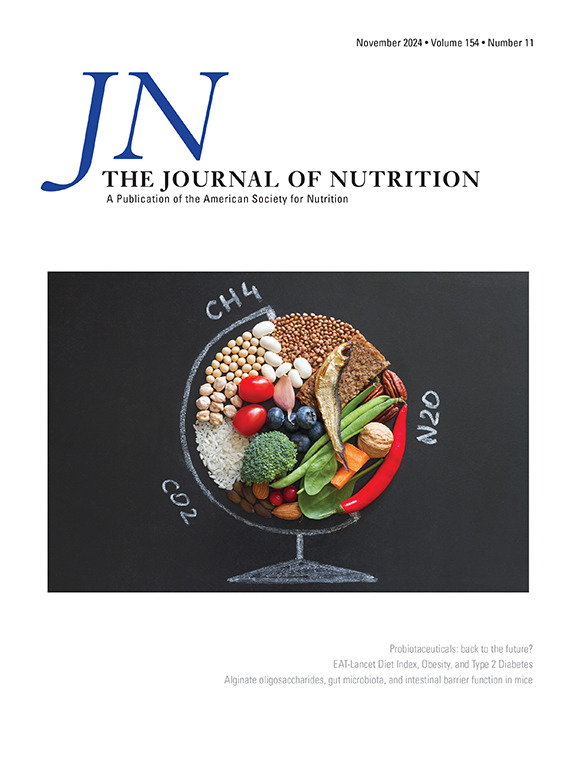Dietary Choline Intake and Risk of Alzheimer’s Dementia in Older Adults
IF 3.8
3区 医学
Q2 NUTRITION & DIETETICS
引用次数: 0
Abstract
Background
Dietary choline intake has been associated with a lower risk of cognitive dysfunction, lessened brain white-matter hyperintensity volume, and a reduced risk of incident dementia.
Objectives
This study aims to evaluate the relationship between dietary choline intake and risk of clinical diagnosis of Alzheimer’s dementia (AD) in participants enrolled in the Rush Memory and Aging Project prospective cohort.
Methods
Participants who were free of AD at baseline and had completed ≥1 food frequency questionnaire were included in the present analyses. Clinical AD was assessed among participants annually using a 3-stage process of neurological examinations and standardized diagnostic criteria. Dietary choline intake was quantified using the United States Department of Agriculture Database for the Choline Content of Common Foods. Multivariable Cox proportional hazard models were used to assess risk of incident of AD by quantiles of dietary choline intake. Mixed-effect Poisson regression models were used to investigate potential nonlinear relationships.
Results
Mean baseline age of the study participants (N = 991) was 81.4 (±7.2) y. During a mean follow-up of 7.67 y, 266 participants (27%) were clinically diagnosed with AD (incident rate = 38/1000 person-year). In the fully adjusted model, compared with the lowest quantile of dietary choline intake, consumption of 200–250, 251–300, 301–350, and >350 mg/d were associated with a 23% [hazard ratio (HR): 0.73; 95% confidence interval (CI): 0.45, 1.17; P = 0.10], 40% (HR = 0.60; 95% CI: 0.60, 0.98; P = 0.04), 38% (HR = 0.62; 95% CI: 0.36, 1.07; P = 0.09), and 51% (HR: 0.49; 95% CI: 0.25, 0.95; P = 0.04) reduced rate of AD, respectively. Results of the curve linear Poisson regression model showed the point of lowest risk for AD to be ∼350 mg/d with effects being similar based on apolipoprotein E gene genotype.
Conclusions
Dietary choline intake ∼ 350 mg/d was associated with the lowest risk of clinical diagnosis of AD in older adults.
老年人饮食胆碱摄入量与阿尔茨海默氏痴呆的风险
背景:饮食胆碱摄入与认知功能障碍风险降低、脑白质高强度体积减少和痴呆发生率降低有关。目的:在Rush记忆与衰老项目(RMAP)前瞻性队列中,评估饮食胆碱摄入量与阿尔茨海默氏痴呆(AD)临床诊断风险之间的关系。方法:在基线时无AD并完成至少一份食物频率问卷(FFQ)的参与者被纳入本分析。临床阿尔茨海默病每年在参与者中进行评估,采用三阶段的神经学检查和标准化的诊断标准。使用美国农业部普通食品胆碱含量数据库对膳食胆碱摄入量进行量化。采用多变量Cox比例风险模型,按膳食胆碱摄入量的分位数评估AD发生的风险。混合效应泊松回归模型用于研究潜在的非线性关系。结果:研究参与者(N = 991)的平均基线年龄为81.4(±7.2)岁。在平均7.67年的随访期间,266名参与者(27%)被临床诊断为AD(发病率= 38/1000人年)。在完全调整模型中,与最低分位数的饮食胆碱摄入量相比,200-250、251- 300、301-350和>350 mg/天的摄入量与23%的相关性(HR: 0.73;95% ci: 0.45, 1.17;P = 0.10), 40% (hr = 0.60;95% ci: 0.60, 0.98;P = 0.04), 38% (hr = 0.62;95% ci: 0.36, 1.07;P = 0.09), 51% (HR: 0.49;95% ci: 0.25-0.95;P = 0.04)降低AD的发生率。曲线线性泊松回归模型的结果显示,AD的最低风险点约为350 mg/d, ApoE基因型的影响相似。结论:膳食胆碱摄入量约为350 mg/d与老年人临床诊断AD的最低风险相关。
本文章由计算机程序翻译,如有差异,请以英文原文为准。
求助全文
约1分钟内获得全文
求助全文
来源期刊

Journal of Nutrition
医学-营养学
CiteScore
7.60
自引率
4.80%
发文量
260
审稿时长
39 days
期刊介绍:
The Journal of Nutrition (JN/J Nutr) publishes peer-reviewed original research papers covering all aspects of experimental nutrition in humans and other animal species; special articles such as reviews and biographies of prominent nutrition scientists; and issues, opinions, and commentaries on controversial issues in nutrition. Supplements are frequently published to provide extended discussion of topics of special interest.
 求助内容:
求助内容: 应助结果提醒方式:
应助结果提醒方式:


